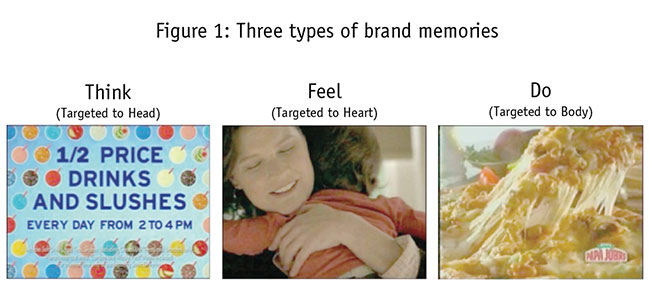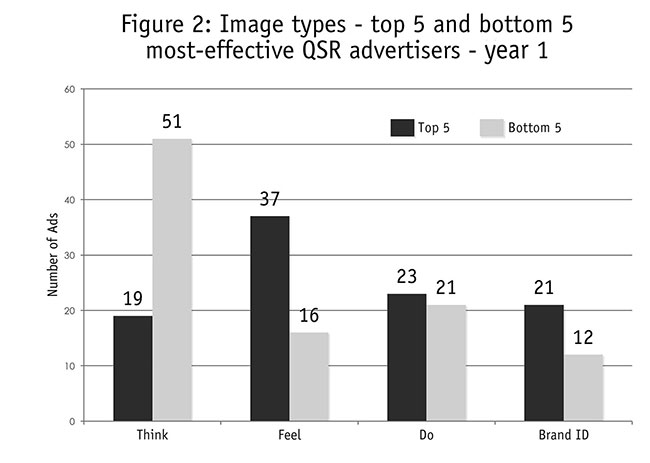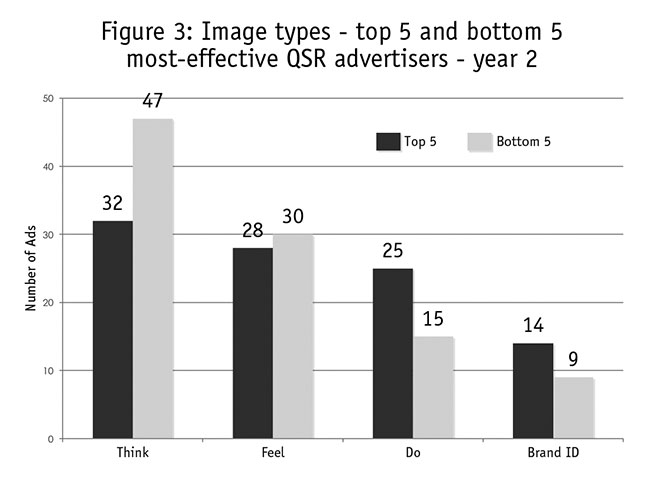A memorable impression
Charles Young is founder and CEO of Ameritest, an Albuquerque, N.M., research firm.
The Nobel Prize-winning economist Daniel Kahneman has had a wide influence among marketers with his popular book, Thinking, Fast and Slow. Many have embraced his ideas about the different roles that System 1 and System 2 cognitive processing play in describing how audiences engage with advertising. What is generally overlooked in Kahneman’s book, however, is the third element: the central role that memory plays in the consumer decision-making process.
Clearly, memory plays a major role in any reasonable model that describes how brands work in the brain. In the Mad Men days of early television, researchers measured the quality of a TV commercial using a day-after recall score. Intuitively, the researchers felt that to affect future consumer behavior, advertising must leave behind some trace in consumer memory. Yet today, for most marketers, recall testing has taken a backseat to measuring emotional engagement through new scientific technologies such as facial response coding or brain wave analysis. And memory itself remains one of the least-understood variables in the psychology of marketing.
Memory, as we now know from neuroscience, is a lot more complicated than we thought. The one-dimensional model of memory (as represented by the traditional recall test of advertising effectiveness) is an oversimplification of complex, multidimensional processes that occur in the brain when a consumer interacts with the many touchpoints of a brand. Our research suggests that strong brands build memories in at least three dimensions of the mind.
Endel Tulving, the senior editor of the Oxford Handbook of Memory and “the father of modern memory research,” was one of the first researchers to describe the brain’s three primary memory modules: the semantic, episodic and procedural memory systems.
This three-dimensional model of memory represents a significant shift in viewpoint from the traditional dichotomy of rational versus emotional that is frequently used to frame the discussion about how advertising works to build a brand.
What are the key differences between the three memory systems?
The conceptual brain. According to Tulving, the semantic memory system is outer-directed and builds mental representations of how the world works – its frame of reference is the universe.
The semantic system processes ideas and uses language and logic for its operations. We associate this part of the brain with abstract thought and metaphor-generation, which helps the brain create categories for organizing our experience of the world “out there.”
Activities strongly rooted in semantic memory include accounting, law, mathematics, education, science and the form-filling, rule-making bureaucracy of government.
For marketers, mental constructs linked to the semantic memory system involve concept testing, the idea of unique selling propositions, brand positionings and advertising strategies (as opposed to execution) that focus on features and benefits and reasons-to-believe proof-points.
Researchers should note that the semantic memory system can be readily accessed through verbal self-reporting – which is what forms the basis of most traditional research methods. It is also the memory system most easily accessed by traditional advertising recall testing.
The social brain. In contrast to semantic memory, the episodic memory system is inner-directed and its frame of reference is experience from the point of view of the self. Episodic memories are organized according to time, not categories. These literal “episodes” build our internal timeline and generate a continuous narrative of consciousness to create our sense of self.
Losing these personalized, autobiographical memories – through Alzheimer’s disease, for example – is particularly painful, as it represents a sad loss of self.
Episodic memory functions through the principle of association – objects, ideas and experiences that frequently occur together connect in memory, even though there may be no logical or causal relationship between the two. And these memories, tagged with emotions such as joy, surprise, sadness, fear, anger and disgust, form the raw material of storytelling.
Storytelling – particularly in its most basic form, gossip – is the communication content that underpins most of our social relationships. Indeed, according to Yuval Harari, the author of the best-seller Sapiens, the evolution of our social memory system may have fundamentally transformed our development as a species. Our social memory system which, like Facebook or LinkedIn keeps track of our social relationships, lets us cooperate in social groups and is probably the most important reason humans occupy the top rung of the food chain.
To emphasize its primary role in social communication, we frequently refer to the operations of the episodic memory system as the “social” brain.
Items rooted in our social or storytelling brain include: politics, literature, movies, television, news, social media, even the greeting card industry and product reviews on Amazon.
Marketers understand the power of effective storytelling, whether of comedy or drama. They understand that appeals to the conceptual, thinking brain are fundamentally different from appeals to the social, feeling brain. And they intuitively understand that storytelling is usually more powerful than logic.
Since stories can be told in both words and pictures, e.g., in books or movies, episodic memories can be both created and retrieved both verbally and visually.
Given the tremendous growth rate of personal videos and photographs (including a great many selfies) being shared on social media channels such as Facebook, Instagram, Pinterest, Snapchat, etc., it appears that the socialization of visual memories is transforming the ways ordinary people communicate.
The physical brain. The third and most primitive (and therefore probably the most powerful) memory system deals with our physical self, not our mental self. Known in the academic world as the procedural memory system, it deals with the basic operational memories of how to perform specific actions, such as riding a bicycle, driving a car or using a spoon.
More generally, this memory system links directly to our physical senses such as the five traditional senses of sight, sound, taste, touch and smell, which is why we prefer to call it physical memory.
It would be a mistake to think that the physical memory system is only linked to a consumer’s physical interactions with the brand. Research into the role of physical memory on a brand’s touchpoints is not just the realm of product research or taste tests.
Mirror neurons, which were discovered by neuroscientists in the 1990s, are a powerful aspect of the physical memory system. These neurons fire in the brain not just when we perform an activity ourselves but also when we watch someone else perform an activity. Mirror neurons form the neurological basis of human mimicry – a fundamental way we learn to do things.
Mirror neurons also allow us to adopt another person’s point of view. When we watch a baseball player hit a ball, we ourselves record the hit of the bat in our own physical memory system. When we watch someone eat an ice cream cone, the mirror neurons in our brain trigger our memories of what ice cream tastes like – which in turn may trigger the desire to buy our own ice cream cone.
Decoding how advertising really works
For marketers, understanding the interaction between the brain’s memory and the mirror systems may become central to decoding how advertising really works in the brain. When we watch someone in a television commercial enjoy a bowl of cereal, wash their hair, drive a car or touch an iPhone screen, it engages our mirror systems and we mentally rehearse doing the same thing – it’s called virtual consumption.
Interestingly, when remembering, the human brain does not distinguish between real brand experiences and virtual experiences. Because of this, virtual consumption memory (a memory created by watching an experience) may become a false memory. Understanding how this Matrix-like phenomenon works is an active area of research study and is likely to become even more important with the influx of mass-market virtual reality and augmented reality technologies.
Activities strongly rooted in the procedural or physical memory system might include cooking food, listening to music, watching sports, playing video games and even looking at pornography (its relationship to virtual consumption is why food marketers call deliciously beautiful pictures of food “food porn”).
Physical sensations are distinct from social emotions, though the two are deeply connected in the brain. For example, psychological experiments have shown that the act of holding a hot cup of coffee in your hands can cause you to form the perception that a person you just met has a “warm” personality.
Although they are deeply connected, the common language we use to describe social emotions and physical sensations can cause confusion about the different roles that emotions and sensations play in the brand-building process.
As the Pixar movie Inside Out illustrated, the word “disgust” can refer to our physical reaction to toxic food or our emotional reaction to a socially toxic person. The word “fear” can describe our reaction to something dangerous in our physical environment or to a person dangerous to our social well-being.
The lack of a well-defined vocabulary for discriminating between specific emotions and specific sensations may be one reason why marketers do not often distinguish between an emotional reaction and a sensory reaction to the different perceptual cues they put in their advertising imagery. But the two are actually quite different in terms of the kinds of memories they create.
All three types of memories are important
In the end, all three types of memories are important for constructing a brand in the mind of the consumer. Some may be more important than others, depending on what’s being advertised. To manage the growth of a brand, should a marketer strive to keep the three types of memories in some kind of balance, at least when looking across their entire portfolio of advertising and other brand touchpoints? Or, to solve a particular marketing problem, should some types of memories receive more emphasis than others? Do the most effective ads create all three types of memories or can an ad be more effective by focusing on only one or two types of memory? These questions are still open for research to answer.
To provide an empirical foundation for that discussion, let’s look at the data on the three kinds of memories generated by a large number of fast-food TV commercials. In a recent meta-analysis, we looked broadly at the most memorable content of all the advertising we tested in the fast-food category over two consecutive years. These years gave us a sample of 590 TV commercials, tested among 59,000 consumers, for the top 16 brands in the quick-service restaurant category, including McDonalds, Wendy’s, Pizza Hut, KFC, etc.
In our testing, we use a moment-by-moment short-term memory test, our Picture Sorts, to predict the long-term memories created by TV advertising. With this diagnostic approach we have learned that the average 30-second commercial creates four peak memories, which are largely responsible for building long-term brand equity through the advertising.
In our study, we use the coding scheme below to categorize each ad’s peak visual memories into areas representing the three memory types:
Concept images: Semantic content contains images that trigger thinking. It is largely identified by information conveyed in words or numbers on-screen. In the QSR category, semantic content might include a special price offer, the word “new” for a new product introduction, a deal for a meal combo or the announcement of a holiday sale or other promotional event.
Social images: Images that generate episodic memories are largely focused on human interactions and relationships, between live characters or trade characters (such as the Burger King “King”) or may even include the body language and non-verbal expressions of a presenter talking to the audience. Social images help answer the question, “How do I feel about these characters and their situation?”
Physical images: The images in this category 1) evoke a sensory reaction, e.g., the tactile reaction to a cheese pull or heat-response to a burger sizzling or 2) cue a relevant rehearsal behavior, e.g., the physical act of a bite-and-smile or a phone call for pizza delivery that the advertiser wants the consumer to mimic.
As illustrated in Figure 1, you might think of the three memory types in terms of images targeted to the head (thinking), the heart (social feelings) and the hand (physical sensations).

In addition to the three memory types, we also coded for a brand identifier: Was the name, logo or even a picture of the store itself in the commercial memory peak?
Having an image identifying the advertised brand in a memory peak is key to brand linkage for the ad as a whole and therefore is important for memory retrieval at the point of a future purchase decision.
Looked at the different memory types
In our analysis, we looked at the different memory types created by the most-effective versus the least-effective advertisers for that year. We grouped the top five brands and bottom five brands as measured by the average Motivation Score across all of a brand’s ads for the year.
When we did so, an interesting story emerged, with a curious variation between the two years (see Figures 2 and 3).


In test year one, the most-motivating brands created fewer thinking-type memories than the least-motivating brands, by a wide margin – 19 percent versus 51 percent. Instead, the most-motivating ads created more feeling-type, social memories, 37 percent versus 16 percent. The most-motivating ads also had more peak memories focused on the brand identifier, 21 percent versus 12 percent, generating better brand linkage overall for the memories being created. In other words, getting consumers to feel, rather than think, was the key to success – especially if those feelings were linked in memory to the correct brand.
In test year two, the story differed slightly. The study again showed the most-motivating ads contained far fewer thinking memories than the least-motivating, 32 percent versus 47 percent. In this year, though, the most-motivating advertising generated more doing-type physical memories, 25 percent versus 15 percent. And again the most-motivating ads had more peak memories focused on the brand identifier, 14 percent versus 9 percent. In other words, appealing to a consumer’s physical sensations, rather than their reason, was the key to success in that year.
Emotional is more powerful
The data indicates that the ad agency creatives are correct in claiming that emotional advertising is more powerful than rational advertising – if, by “emotional” we mean either socially-connected memories or memories of physical sensations.
However, it is not certain that this is true in all cases. For example, in a non-food category with introductory advertising designed to launch a new product, it is likely that getting consumers to stop and think about a new product, its reason-for-being and a demonstration of its advantages versus competing products will play a more important role.
The insight from this analysis challenges marketers to think more deeply about advertising on a “not-rational” level: In terms of imagery, focusing your advertising on creating social memories is a very different creative strategy than creating sensory memories.
Understanding how to create all three types of memories for a brand and how to balance them in your category to solve a given creative problem can empower you to design more effective strategies to grow a three-dimensional brand, one that is fully present in consumer memory.
